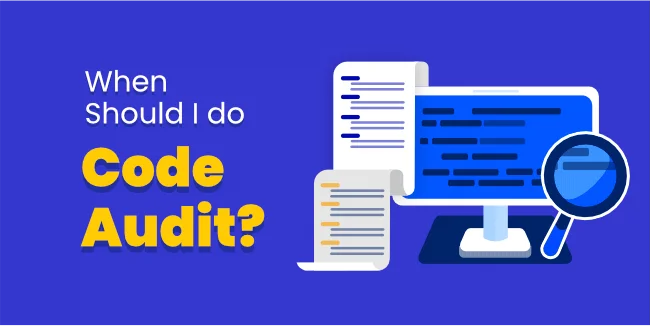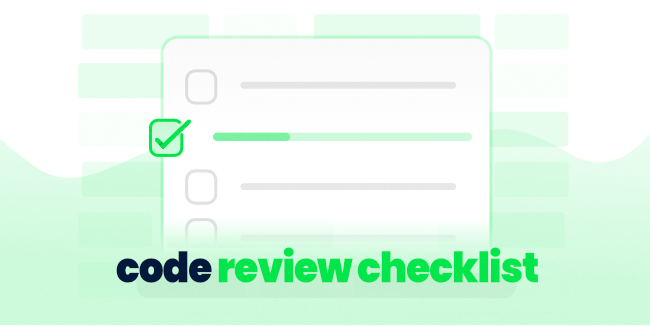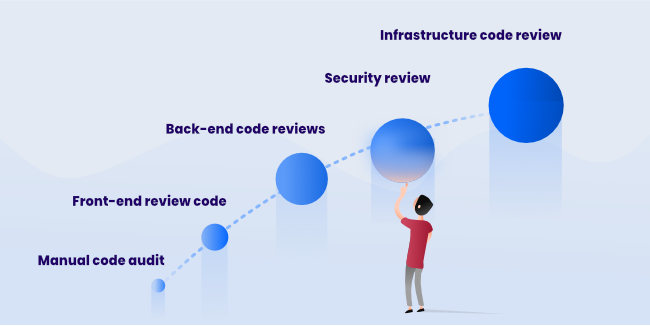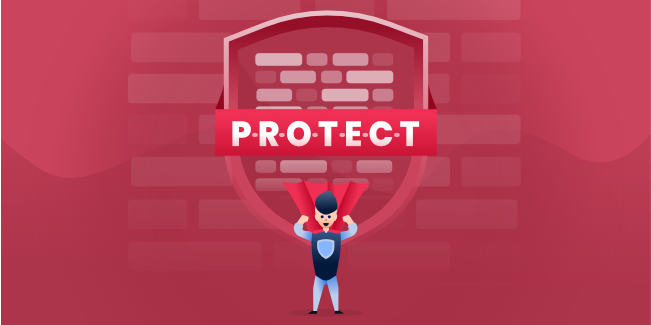mvp
prototype
guide
Concept
proof
When should I do a code audit? How do I do that?

We at mDevelopers have met clients who had lots of issues with code and architecture. One of them had a big system which was crucial for the business in the market. Our team analyzed the whole code, and in the process, it appeared that the project would be challenging both for the client and us. The system had been created 7 years earlier, and, during its construction, several freelancers and companies had been working on it.
The code and architecture were a complete mess. We had two options to manage that. The first was to fix code and architecture based on what we already had. The second opinion was to build the whole system from scratch. In that case, the second option was faster and less costly...
If you do not want to face such dilemmas, it is good to immediately contact an offshore outsourcing company whose experience will definitely help you create the code you want.
If a code audit had been performed earlier, the whole system would have been salvageable.
That extreme example shows it is worth having a structured code audit process and doing it regularly. It gives us insight into the health of our product and the possibility to react quickly.

This article will give you knowledge about what is and when to do a code audit. You will know what elements a code review consists of. Last but not least, we will give you tips for a cost-effective and time-saving process.
A code review is a software quality assurance procedure in which one or more people examine a program mainly by looking at and reading portions of its source code after it has been implemented or during the process of implementing it. The code reviewer must not be the program's author.
An audit focuses on:
- Better code quality - Is what the developer intended good for the users of this code? The “users” are usually both end-users and developers (who will have to “use” this code in the future). Is this code's developer aware of, and/or concerned about, the impact his or her work will have on users? The "users" are often both end-users and developers (who will need to “use” this code in the future). Better code quality has a few elements like naming, comments, style, and consistency of the former.
- Finding defects in code - like performance problems, security vulnerabilities, injected malware.
- Finding better solutions - generating new ideas.
- Complying with QA and development standards.
- Architecture design - Do the connections between various pieces of software in the system make sense?
- Complexity - if the system is not too complex, maybe the code or functionalities can be written more simply.
- Performance and scalability check.
- Potential issues.
- Current technology stack.

The goals of software code review may be classified into various categories. It's not necessary to inspect the whole product very frequently. It would take too much time and effort. Occasionally, a mere check on isolated sections of the product is all that is required.
The main types of software code audits are:
1. Manual code audit
A manual code audit is the first and most basic indication of the code structure. A manual code audit aids in determining whether the code is written according to common standard practices.
2. Front-end review code
A code review on the front end can help you discover issues related to parts of the code that create a positive user experience. You can extend it with a UX audit
3. Back-end code reviews
The back-end code audit calculates the overall code complexity. It aids in determining whether the software is stable and secure, whether it’s cross-platform or native app development. Issues such as outdated tools, technologies, and code structure are all scrutinized by the auditors.
4. Security review
The security code audit is used to examine the effectiveness of security measures and check whether any data access limitations exist. It also aids in the detection of data breaches that might result in information leaks.
5. Infrastructure code review
The first step in the infrastructure audit is to look at how the servers are performing. We ensure that the architecture is secure and that the servers are up to date, eliminating any security concerns.
A cloud infrastructure code review aids in the optimization of servers and security. If a product's usage of cloud space or computers exceeds what is required, such an audit will identify methods to lower these expenses.

Long story short, a good code audit service helps to:
- find out-of-date tools,
- determine the security risks,
- discover inappropriate development practices,
- maintain the product,
- avoid costly mistakes from existing and potential bugs,
- improve code quality.
A code review can help to avoid risk areas and more profound problems in the future. It allows upgrading the quality, maturity, and maintainability of a product.
When to do a software code audit?
There are several reasons to perform a comprehensive code audit. Each case is unique, but we may certainly highlight the most prevalent ones:

1. To avoid technical debt
Code debt, also known as technical debt (tech debt or code debt), is the term used to describe what happens when mobile app development teams make efforts to speed up the completion of a piece of functionality or a project. In other words, it's the consequence of putting speediness ahead of perfection in coding. It's possible to write all of this off as insignificant, but let me remind you that technical debt is a real concern for app developers. Making modifications or upgrades to an app or other product, such as adding new features or upgrading it, can increase technical debt if the process isn't strict. Ensure that whatever you're adding doesn't create problems.
2. Finding weak points in source code
Regardless of how long your product has been in existence. Whether it's a startup or an older project, you can discover flaws everywhere. It's possible to identify serious and minor vulnerabilities in any codebase. Or figure out which technologies are no longer supported. Or even get guidance on the technology stack to use if you want to adopt a better software solution
3. When you are buying or investing in the new app
You're either buying a firm as an investor, or you've just completed a merger, and you need to do due diligence. You're either buying a firm as an investor, or you've just completed a merger, and you need to do due diligence. You've acquired a company with assets that include an app or other type of digital product. The results of a thorough code audit can help you find out how much time and money you need to invest in the product to make it work well or maximize the product's potential and follow your strategy.
If you're seeking investors, selling a firm, or have a part-business that offers digital items, performing a comprehensive examination allows you to honestly and with less risk of return or future problems. Not to mention the obvious concern of legal responsibility.
4. Risk management strategy
A risk management strategy must be included in any business's plan. A software code audit of the product may reveal flaws. If there are problems, they may have an impact on your company's foundations. It will assist you in locating and eliminating threats.
5. Launching a new product
It is an apparent time to make sure your product is suitable for its intended use. Make sure it's the greatest it can be before passing it on to your target users. The code is crucial, but so is the appearance, feel, and experience of the product. Your app may have fans or acquire detractors based on how people think about it.
Another example is when you outsource the production of a digital product and want to assess the quality. Did the agency do an adequate job, and is the product suitable for user requirements?
6. Security check
Now that we all are aware of the need for data security, it's no surprise that not every product can keep data safe from intruders.
A weak codebase can have a devastating impact on the security of your product. It might security breaches (expose your data), create vulnerabilities, allow hackers in, or even facilitate fraud.
After examining the code, you will find and repair any security flaws to make your product more secure and safeguard your development team members and customers.
7. Users are experiencing problems
It might be due to a lack of or an absence of auditing in the past, or perhaps people are using the software in ways that weren't intended. Warning signs that suggest an audit of:
- When your product has errors,
- Users are reporting issues with the software,
- Your product is sluggish,
- You can use it because it's not responsive, but you shouldn't,
- When new features, updates, and patches are causing more difficulties than they're resolving.
8. You are scaling product
It's possible that a native or multi-platform mobile app development that works well when scaled down won't function when thousands of users are attempting to use it simultaneously. When you're going from a small to a large market or want to expand to a new area, performing an audit on your product is critical. You can't argue with success, but there are ways to make sure all the pieces come together. Again, you may think that your code and other technical details are up to par, but how does the user feel when they have to wait five seconds longer for the website to load or the mobile version is too hefty for mobile bandwidth in a remote region.

9. Maximize the potential of your product
You may want to discover the existing potential to improve the performance of your digital product. After all, if there's a method to improve performance, enhance the UX, and expand your user levels and business reputation, why wouldn't you? A code audit is a method for detecting savings potential or new development directions with business value.
10. The product is old
To discover flaws and mistakes, you'll need fresh eyes. It's that easy sometimes. However, if your digital product has been unaltered from the start or has been unchanged for two years, there is certainly room for improvement. Otherwise, it might cause difficulties similar to those associated with outdated software: security concerns, technical debt, old and bad code, and finding defects.
11. When you change software development partner
It's best to do a complete code audit at this point to learn what the application "truly looks like under the hood" before proceeding. Discovered issues will save time for you and your new software development partner because you can communicate goals to new software engineers at the very beginning of cooperation.
How to do code reviews?
Now how to conduct peer code review? Reviewing code is a broad topic, in this paragraph, we will show you what the process looks like in the many teams and give you a snapshot of our guidelines on how to create comprehensive analysis and achieve high-quality code.
- First of all, The first step is to determine your project or business objectives and needs. What key elements need the most attention, and will you want to focus on them? Make sure you agree to a predetermined process that meets your company's expectations.
- We will study the code that has been written. We will check for problems or mistakes in it. Then we will make sure that there are no more risks and costs before we move on to the next phase of this project. The likes of the frontend and backend, as well as containers, data planes, certificates, and drivers, are all on the list for evaluation
- Your software team should test every project component using a combination of static analysis tools. Identify areas of duplicate code and several additional potential security concerns using this technique. The programming language used in the code may ultimately determine the type of tool you'll need. These are just a few examples of static code analysis tools. CodeClimate, CSSLint, Pylint, RailsBestPractices, Reek, Rubocop, and others are several static code analysis tools available.
- Automated checks without manual code review aren't an element of a comprehensive report. Developers inspect and analyze the project's code at this stage. Developers perform a deeper analysis of the project's code, known as the ‘second layer' investigation. This stage also includes tracking. While this phrase has as many activities as before, it is a fail-safe against software failure. Developers can also contribute helpful information since they have knowledge and subjectivity. Their expertise ensures proper database design, test coverage, data structure, and other features in this case. It is the power of manual review!
- The next stage in the code review process focuses on scale and infrastructure. There are potential problems or bottlenecks with the code. When these contaminants reach an already compromised infrastructure, they can exacerbate system operations' scalability problems. To solve this, we employ application penetration testing, in which we look for flaws. However, it does not give us the code's source code locations. It may be thought of as an attack simulation. Our goal will be to use a variety of attack methods while giving it our all. It is meant to target potential access points into your system. It is to reduce the severe risk areas and impact of the application on the user. Do not be concerned - it's a controlled exercise. Nothing will be destroyed or demolished.
- After that, we created a document called "code audit report." The quality of your application is evaluated using this checklist, which also contains a series of component evaluations
Elements of a professional code review process
Suppose you are curious about what elements, tools, approaches are used and what best practices, project, and architecture patterns are checking in the most effective code analysis.
Tips for cost-effective code audit
Offshore code audit
As we said in the previous paragraph, a good option is to take external experts to such work when reviewing code. It will help to avoid the mistake of knowledge blindness.
Make a list of everything you need to do
It's possible to achieve your objectives if you keep things simple. We propose that you get organized before beginning an audit. Make a list of the items that need to be audited.
The most significant advantage of such a strategy is that it will help you organize the auditing process. . As a result, you will spend less time and money reviewing code and verifying all critical regions to save resources and time. And be sure no significant risk areas are left unaddressed.
Conduct both automatic and manual testing
When it comes to detecting visible problems on the surface, performing a manual audit is ideal. The more in-depth your research, however, the better for your product. Automated testing enables us to discover deeper issues and produce more efficient code analysis. It speeds up the whole code auditing process by automating testing. Therefore, you avoid problems and extra costs in the future.
Regularly audit your code
We recommend performing code inspections on a regular basis. At least once or twice a year is good. During the normal product development process, review the code on a regular basis. As a result, you'll have more chances to notice major concerns early in the game.
If you detect an issue later, the cost of correcting it is greater, like we said at the beginning of this article. Remember?

What next after code review?
Any code audit, however, should result in a list of problems to be addressed. If you're truly interested in examining your digital product and want to go deeper, though, you may anticipate considerably more:
- The audit report should first recommend strategies to address each concern, providing details on the available "fixes" and, where relevant, the costs and benefits of each.
- Furthermore, issues and recommendations should be prioritized based on how important they are to your users and your company. Whoever carries out the audit must thoroughly understand your wider business environment and context.
- Last but not least, you should anticipate more than simply a paper document. Whether it's a formal presentation of the findings or a one-on-one phone or video session with the auditor (or audit team representative), you need the opportunity to talk about the audit results so that you can grasp not just what they're saying but also why they're saying it.
After receiving documentation, feedback, and prioritizing issues, you can start fixing errors.